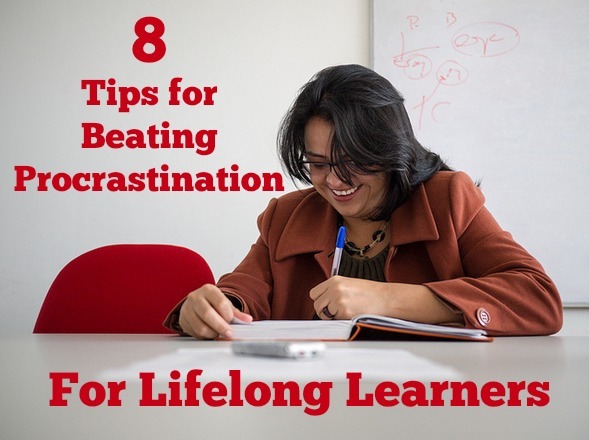
To be a successful lifelong learner you need to overcome procrastination.
I’m a lifelong learner, and I’m sure that most of my blog readers are as well. Being a lifelong learner makes you well-rounded, keeps you competitive, and helps you to succeed in life. However, one of the obstacles that can get in the way of learning new things—whether it’s learning a language, acquiring computer skills, learning business skills, and so on—is procrastination.
 I recently took a MOOC called Learning How To Learn: Powerful Mental Tools to Help You Master Tough Subjects. It was created by the University of California, San Diego, and is taught by Dr. Barbara Oakley, who’s a professor of engineering (and others). It’s a fantastic course–which I highly recommend–and one of the topics covered in the course was procrastination. Although conquering procrastination is important for any life area, it’s particularly important for learning.
I recently took a MOOC called Learning How To Learn: Powerful Mental Tools to Help You Master Tough Subjects. It was created by the University of California, San Diego, and is taught by Dr. Barbara Oakley, who’s a professor of engineering (and others). It’s a fantastic course–which I highly recommend–and one of the topics covered in the course was procrastination. Although conquering procrastination is important for any life area, it’s particularly important for learning.
This is because in order to learn well, you have to do it bit-by-bit. It’s similar to a body builder building muscle through day-to-day exercise.
If you cram before a test or before you need to demonstrate what you’ve learned, you won’t be building a solid neural foundation. By getting started early and spreading your study sessions over time, you’ll learn better. That’s why tackling procrastination is so important for learners.
Below you’ll find 8 tips for beating procrastination for lifelong learners which I came across in the Learning How to Learn MOOC.
1. Get Over the Negative Stimulation
When you think of doing something that you would rather not do—such as study for an exam, work on your video course, or listen to another lecture of a MOOC you’ve enrolled in—you activate the areas of your brain associated with pain. Therefore, your brain looks for ways to stop this negative stimulation.
It does so by switching your attention to something else. The process is as follows:
- You feel discomfort at the thought of sitting down to learn how to use a new software program.
- You switch your attention to a more pleasant task—maybe you watch a YouTube video, chat with a co-worker, go on Twitter, or work on an easy low-priority task.
- You feel better–at least temporarily.
- A while later you start to feel bad because you still haven’t gotten around to the software program.
The good news is that there’s a way to overcome the discomfort that you feel when you think of working on a task that fills you with apprehension. Researchers have discovered that not long after someone starts working on a task that they would rather avoid, the neural discomfort disappears.
The trick, therefore, is to tell yourself that you’re going to work on the task for a small amount of time – say, fifteen, twenty, or thirty minutes.
By committing yourself to a limited amount of time during which you’re going to work on an uncomfortable task, it’s a lot easier to get started. In addition, as was just stated, once you get to work on the task you’ll discover that the discomfort disappears.
2. Process vs. Product
In order to stop procrastinating, focus on process instead of product. Process refers to the flow of time and the actions that you take during that time. On the other hand, product is an outcome. Here’s an example:
- If you want to create a video course, the video course is your product. The product is what triggers the pain that leads to procrastination. If you place your attention on the video course that you want to create, it’s very likely that you’ll procrastinate.
- What you have to do instead is focus on the process. That is, the chunks of time that you need over days or weeks to complete the course. Focus on each work session, instead of focusing on completing the course.
By focusing on process you can relax into the flow of the work, instead of worrying over whether the video course is going to be good in the end, if you’re almost done, what your customers will think of the course, and so on.
Here’s a quote from Chilean writer Isabel Allende that perfectly illustrates this point: “Don’t be paralyzed by the idea that you’re writing a book; just write.”
3. Identify the Triggers that Make You Procrastinate
Procrastination is an automatic habit, so most of the time you’re unaware that you’ve begun to procrastinate. In order to stop procrastinating you need to identify the cues that trigger the habit of procrastination. These triggers could be things such as the following:
- You decide to check your email for a moment and end up spending half an hour reading and answering emails.
- You decide to look something up quickly on the Internet and find yourself surfing the web for forty minutes.
- Your cellphone rings, you answer, and then proceed to chat away with a friend for twenty minutes.
- You decide to get to work on your video course but you feel uncomfortable since you’ve never created a video course before and you’re unsure of what to do. You find yourself organizing your files instead of working on your video course.
Once you’ve identified the triggers that make you procrastinate, and how you respond to those triggers, you’ll begin to get better at noticing when you’re procrastinating so that you can stop yourself and get back to work.
4. Create Positive Study/Learning Habits
By creating positive study/learning habits you’ll be able to overcome procrastination. There are three steps to creating a new habit. The steps are the following:
- Cue
- Routine
- Reward
A cue is a signal to begin a specific action. As an example, putting your fork down as soon as you’re done having lunch can be your cue to start studying. The routine is the action that you’re going to take once you receive the cue. That action could be to shut the door to your office, turn off all distractions, sit at your desk, and start studying.
Once you’ve taken the action that you planned, reward yourself. Your reward can be things such as the following: savoring the fact that you completed the task, getting a cup of flavored coffee, having two squares of dark chocolate, taking a quick nap, doing a puzzle, playing a video game, and so on.
5. Believe You Can Do It
In order to overcome procrastination, it’s vital that you believe that you can do it. Believe that the steps that you’re taking in order to create positive habits that will allow you to stop procrastinating are going to work. Gain trust in your new system.
6. Plan Your Day the Night Before
Research has shown that if you prepare your to-do list the night before, then during the night–as you sleep–your subconscious will grapple with the list and come up with ideas on how to accomplish the items on the list.
If you don’t create a list of what you need to do, then the tasks that you need to get done will lurk in your working memory, taking up valuable mental real estate. Once you make a task list, this frees up working memory for problem solving.
7. Make Notes About What Works and What Doesn’t
As you work to create an efficient system that allows you to overcome procrastination, make notes about what works and what doesn’t. This can include things such as the following:
- Write down which environments you work well in, and where you find yourself getting distracted.
- Are there certain times of day when it’s easier for you to get to work on important tasks?
- Do you need to sprinkle more fun activities throughout the day so that you can really get yourself to sit down and get through the most important tasks on your to-do list?
- Do you need to plan your quitting time at the end of the day in order to give yourself an artificial deadline that you’re going to work hard to meet?
- Those times in which you succeeded in getting things done, what did you do? How can you replicate what you did?
By keeping notes you’ll be able to tweak your system until you’ve perfected it.
8. Give Yourself Some Leisure Time
Time and time again, those who give themselves some leisure time outperform those who doggedly pursue an endless treadmill. Once you’re done with all of your tasks for the day, relax and have some guilt-free fun.
You can meet friends for dinner, play a game of tennis with your significant other, go out dancing, and so on.
Conclusion
Live your best life by being a lifelong learner. In addition, use the 8 tips above to make sure that procrastination doesn’t stop you from learning new things.





Related Posts:




 Marelisa Fabrega is a lawyer and entrepreneur. She holds a Bachelor of Science in Business Administration from Georgetown University in Washington, D.C., as well as a Juris Doctor from the Georgetown University Law Center. You can learn more about her
Marelisa Fabrega is a lawyer and entrepreneur. She holds a Bachelor of Science in Business Administration from Georgetown University in Washington, D.C., as well as a Juris Doctor from the Georgetown University Law Center. You can learn more about her 





